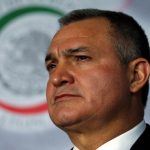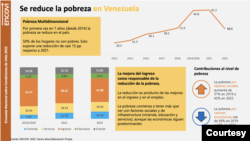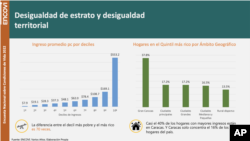For the first time in seven years, multidimensional poverty was reduced in Venezuela, but inequality increased, becoming the “most unequal” in the region from the point of view of income, according to the Survey of Living Conditions (ENCOVI) 2022, presented Thursday.
“Venezuela is in the most unequal continent in the world and, by 2022, it is the most unequal country in the Americas. Our level of inequality is compared to that of Namibia, Mozambique and Angola”, reveals ENCOVI.
The difference between the average income per capita by deciles between the poorest and the richest is “70 times” and almost 40% of the households with the highest income are in Caracas, which only concentrates 16% of the country’s households, research needs.
During the presentation of the survey, the ENCOVI researcher, Luis Pedro España, explained that the fundamental cause of multidimensional poverty, which fell to 50.5%, are economic reasons, but “they are losing weight and what is left are social causes”.
“We have had an improvement in income, but there has not been an improvement in social dynamics (…) the economy may continue to do well, but families will not continue to do well because for economic dynamism to become in social welfare, market distribution is not enough, public policies are needed”, specified the sociologist.
Spain, also director of the Center for the Third Sector of the Andrés Bello Catholic University (UCAB), stressed that, in order to reduce inequality, a strategy is needed to produce goods and services that allow increasing the human and social capital of the most impoverished sectors. .
Regarding households without food insecurity, the figure went from 11.8% in 2020 to 21.9% according to ENCOVI.
“Two out of ten households in Venezuela have no concern about whether they are going to run out of food or not and that, of course, is good news and that is courtesy of the liberalization of the economy, the increase in supply, the increase in income. , but these improvements are likely to stagnate if we do not have social policies”, insisted Spain.
The ENCOVI is a project led by technical teams from some of the most important universities in the country, which arose in the absence of official statistics linked to social reality and has become the largest source of “timely” information for researchers and, in general, Venezuelan civil society.
The research records the recovery of economic activity and income levels, especially in the transport, finance and public administration sectors; Regarding remunerations, it also shows a recovery.
“Public employees $113 per month, private employees $149 and self-employed $142. These levels were at a third in the last presentation. Another important piece of information is that the formal sector of the economy is recovering, growing 7.7 percentage points with respect to the previous year”, Spain specified.
The research exposes that State institutions continue to be “weak” in their actions to promote opportunities and meet the needs of the most vulnerable populations and underlines that, in 2022, a “slowdown” in the level of economic activity has been observed ( 7.2%) compared to the second half of 2021 “and is forecast to still fall in 2023 (4.4%), to levels insufficient for recovery to pre-crisis levels.”
“A combination of factors account for these results, which have to do with the deterioration of infrastructure and basic services, poor access to bank credit, lack of human capital, low level of real income of consumers , the low growth of oil production, as well as the effects of some sanctions”, exposes the investigation.
Last week, according to estimates from the Venezuelan Finance Observatory (OVF) for the third quarter of 2022, economic growth slowed considerably.
“After experiencing expansions of 15.9% and 14.9% during the first and second quarters of 2022, economic activity showed an increase of 9.8% during the third quarter of the current year, significantly less than the two quarters previous”, points out the OVF, an independent entity that emerged in the face of official opacity to contribute to the preparation of economic and social statistics.
The ENCOVI specifies that, although the situation of hyperinflation that has occurred since 2017 has been overcome, Venezuela is still listed as the “most inflationary economy in the world, estimating that it may close this year at 125%.”
On several occasions, President Nicolás Maduro has insisted that Venezuela has registered the “greatest” economic growth in Latin America and the Caribbean.
“The real economy, not that of papers and little lies. It is the economy that produces goods, wealth, the real economy of Venezuelans (…) prepare for the auction of the year, October, November and December, that you are going to be crazy and crazy about what will be the sale of the ventures in Venezuela ”, he said in August during an activity with entrepreneurs.
Fall in educational coverage
Approximately one and a half million children and adolescents remained outside the educational system in the 2021-2022 period, one of the aspects of greatest concern for ENCOVI researchers.
Anitza Freitez, coordinator of the ENCOVI Project, explained that the reduction in educational coverage is focused on the population between 3 and 17 years old, and warned that there will be generations that will advance in their educational trajectory with the “deficits” that intensified during the COVID-19 pandemic.
In addition, he highlighted that the editions of ENCOVI reiterate that the main reason that leads adolescents to drop out of school “is not the economic factor, but rather the lack of relevance of the educational offer.”
However, according to the director of the UCAB Research and Social Institute, in the case of educational coverage of the population aged 18 to 24, a “small rebound” has been observed.
Freitez stressed that Venezuela continues “acknowledging the effects” of the reduction in the demographic size change that was registered as of 2015 due to the effect of migration, the increase in mortality and the birth deficit, as a consequence of the migration of the younger population. .
“These generations are going to be left with these deficits over time and it is going to be similar to the population pyramids of countries that were at war where the young population was lost due to the effect of mortality due to the war. For us, it has not been because of mortality, but rather that this population is distributed throughout the world,” said the researcher.
The Venezuelan population in 2022 has been estimated at 28.3 million people according to ENCOVI.
Connect with the Voice of America! Subscribe to our channel Youtube and turn on notifications, or follow us on social media: Facebook, Twitter and Instagram.













